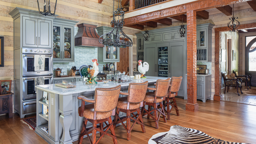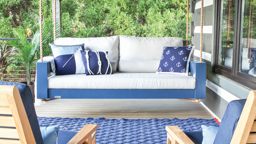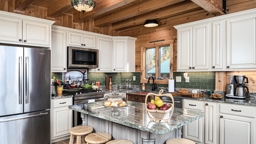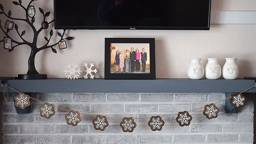Weight of Wood
When it comes to design, the only fear is fear itself. So it's important to trust your instincts when planning your log home's walls. If you're a traditionalist, you may want wood (full logs, half logs, tongue-and-groove paneling, etc.) at every turn, with no exceptions. In that case, you'll want to focus on keeping it light. High ceilings, generous windows and low-voltage lighting will help. "Also use a light-colored stain–either a clear neutral or a whitewash–to make the room feel brighter," suggests Jay Parmeter, president of Golden Eagle Log Homes in Wisconsin Rapids, Wisconsin. Another strategy for "opening up" your log home is to use a little drywall or plaster. In the pursuit of harmony, these materials give the eye a "rest" from the wood–and can even help enhance your logs' natural beauty by allowing you to see the forest and the trees.
Blank Canvas
Drywall offers little mystery: it's gypsum (hydrated calcium sulphate) sandwiched between two sheets of basic cardboard. It is more affordable than wood and plaster–and it's a breeze to install. In log homes, drywall increases design flexibility. For contrast overhead, finished drywall looks great between cathedral ceiling joists or as part of a purloin roof system where the beams run horizontal to the roof line. Drywall also gives log home owners more decorating options by providing a simple, flat surface for adding color and hanging artwork or photographs. Like logs, drywall also absorbs some noise. Another option for non-log walls is plaster, which is simply a thin coat of cement. Plaster boasts similar design flexibility, including both smooth and textured finishes. But it's far more durable and soundproof than drywall. Plaster also ages well. Unlike drywall, it has no seams that may wear with time, heat and humidity. Plaster also takes paint, stenciling, murals and other finishes better than drywall. But there are some drawbacks, too. "Working with real plaster is a long process, involving a lot of "wait time" while the base, medium and skim coats dry," says Matt Franklin, design manager with Precision Craft Log & Timber Homes in Meridian, Idaho. "You also have to sand between the coats. And the color is mixed in directly with the plaster, so it's fixed." In other words, if you're unhappy with the hue, you can't just repaint over the clumpy surface.
Faster Plaster
Several log home pros said that Venetian plasters are the "in" trend for accent walls. Inspired by Old World design, this technique adds texture to drywall so it looks more like stucco, tile and other rich surfaces. Here's how it works: After drywall is installed, it's sprayed with wet clumps of drywall to create a nubby texture. A trowel is then dragged through–creating high points and low points similar to stucco. As an alternative to tile or marble, Ardenne "Sam" Jeffrey, a design manager with Town & Country Cedar Homes in Petoskey, Michigan, offers this idea: Paint drywall a linen color, apply stencils, then trowel white plaster over them to create a simple pattern. "After the stencils are removed, you get a 3-D, tone-on-tone effect," she says. "For an antique look, you can also use a cloth to rub on a tinted glaze." Venetian plaster can go most anywhere in a home. But many owners use it for their bathrooms, where the light-reflecting material pairs well with metal faucets and other shiny surfaces.
More information ran in the September 2005 issue of Log Home Design Ideas.











